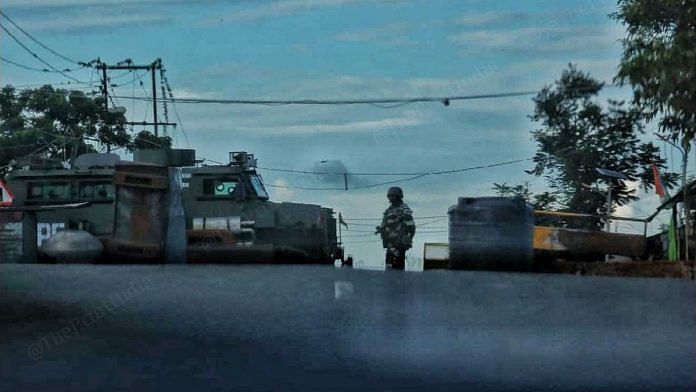After ‘closing’ up the west, India hopes to shut out the east as well, so as to secure itself against the unwanted types. This really is what seems to be the purpose of Union Home Minister Amit Shah’s announcement at an Assam Police commandos event. He declared that India would now effectively seal its border with Myanmar by constructing a fence along the line that divides the two neighbouring countries.
His comments were followed the next day by an extraordinary diatribe against central security forces by the incompetent Chief Minister of Manipur, N Biren Singh.
The Myanmar border-fencing idea isn’t a masterstroke. Its genesis, of course, is the complete collapse of Manipur as a functioning administrative entity since the writ of the state has come under severe strain. The socio-political divide within the state is akin to a civil conflict, which is being exploited to adopt extreme positions.
The ‘otherness’ of those not one’s own has ignited a belief that the ‘outsider’ is solely to blame for the civil-war like situation, conveniently shifting goalposts that didn’t anyway have a sure footing in the first instance. And which ignores the complexity of India’s populace, east and west.
The Myanmar border, for instance, runs along the boundaries of four states in India, from Arunachal Pradesh, Nagaland, Manipur, and on to Mizoram. Residents of each state have had familial connections with adjoining areas of Myanmar over many centuries, long before the concept of international borders came to become sacrosanct in this part of the world. The government of Manipur is, of course, using the pedestrian gripe about Kuki tribals being ‘illegal migrants’ to push its case for raising a fence along the Myanmar border. India’s home minister has echoed that call, ignoring sociology, history, and topography.
As the Myanmar border runs along dense forests, it will be impossible to completely seal the man-made line. So, the common kinship ties, currently validated by law and prevailing customs, will slip into the surreptitious category given that the border will remain porous. And given the current state of affairs in Myanmar, with the military in conflict with democratic forces, such kinship bonds will remain as important as they’ve always been. In certain respects even more so, something Mizo civil society and political class has repeatedly made clear. Despite decades of thwarting, kinship continues to happen towards India’s west.
Also read: Beijing is making inroads, Delhi is building fences. India shouldn’t give up on Myanmar
Borders are hard to fence
The western border fence with Pakistan came up as a response to Khalistani attacks in Punjab and construction happened in patchy stop-start moves. It was not until the 1990s that the entire stretch, including parts of Gujarat and Rajasthan, came to be fenced. And then in the next decade, work began to extend it into Jammu and Kashmir.
Despite the difficulty of crossing the fence, contraband items continue to be smuggled. Locals in Rajasthan even recount the number of times goats have crossed from either side of the divided desert. Marriages still happen through passports and visas, in spite of hurdles.
The most intensely guarded fence is without doubt the Line of Control separating the armies of India and Pakistan. With every possible technical backup, and regular patrols, Pakistani terrorists are still able to infiltrate. The recent past in Poonch is a case in point, particularly. It happens simply because it is not possible to completely shut out a people, be it innocents or with ulterior motives. The United States has spent enormous amounts of money to stop migrants entering from Mexico, and yet hundreds manage to make their way in every day, and night. And those with ulterior motives recently destroyed a fence.
The billion dollar fence put up to encircle Gaza, and announced with much fanfare, came a cropper on 7 October 2023 when the Palestinian resistance groups stormed through it en masse. The tactic of suddenly rushing at a target is intended to disorient the defender, and when implemented on the Gaza fence, it succeeded beyond anyone’s imagination. So much so that explanations began soon thereafter, which do nothing to enhance security, or justify the enormous monies spent. Prescient observers had then remarked about the utility of depending on the fence for Israel’s security. But quickly lost in an euphoric fanfare.
Geography and sociology are paramount when making plans like ambitious fences. Terrain is best managed through observation, surveillance, and intelligence. All depend on excellent human relations, between security forces and the people. National security begins with people, especially those who perceive alienation. The wars of the 21st century pivot on their perceptions, so it is essential to keep them in mind, as the US Defence Secretary made a percipient observation, “In this kind of a fight the centre of gravity is the civilian population. And if you drive them into the arms of the enemy, you replace a tactical victory with a strategic defeat.”
Manvendra Singh is a Congress leader, Editor-in-Chief of Defence & Security Alert and Chairman, Soldier Welfare Advisory Committee, Rajasthan. He tweets @ManvendraJasol. Views are personal.
(Edited by Prashant)




Manipur collapsed? This is Amritkaal, Modi has not said anything about Manipur, so all is good. Period.